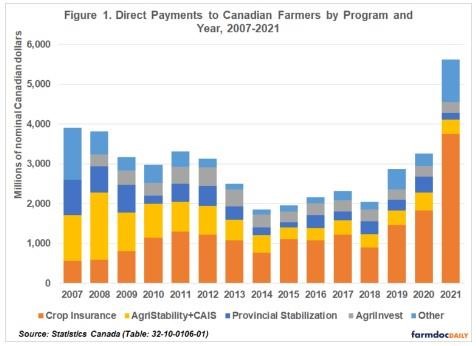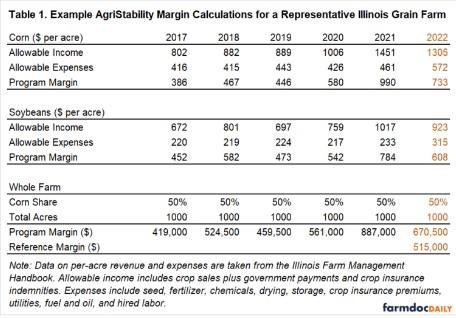By Joe Janzen
Department of Agricultural and Consumer Economics
University of Illinois
Introduction
High farm input costs, especially for fertilizer and fuel, have reinvigorated arguments for farm support programs where payments are triggered when the cost of production rises. Historically, cost of production has been a focus of farm policy in periods of elevated price inflation (farmdoc daily September 15, 2022) Current policy discussions have included the concept of margin protection, that is making farm payments when margin, the difference between revenues and production costs, shrinks. In previous articles in this series (farmdoc daily September 22, 2022 and October 6, 2022), we discussed difficulties involved in quantifying production costs that vary across commodities and regions. These differences makes it hard to design a margin protection program that targets program payments to actual farm-level losses.
An alternative is to determine program payments based on changes in margins that occur on individual farms, similar to how some crop insurance programs define losses based on the difference between a farm’s actual production history and realized yields. Making payments based on margin declines observed at the farm level is intended to improve payment targeting and avoid making payments to farmers who did not experience economic losses.
Farm safety net policy in Canada has included such a farm-specific margin protection program since the early 2000s. The AgriStability program (and its closely related predecessor, the Canadian Agricultural Income Stabilization, or CAIS program) makes payments to a given farm when margin in a given year falls below a farm-specific long-run reference margin. This article reviews the details of Canada’s AgriStability program and discusses lessons from that program for a prospective margin program in the next Farm Bill. Farm-specific margin protection programs can improve targeting of payments to realized losses, but they are considerably more complex. Such programs require additional data from farmers and mechanisms to avoid moral hazard (where farmers change behavior to trigger program payments.) These requirements make program payments less timely, more difficult to understand, and ultimately diminish farmer perceptions of the value of the program.
Description of Canada’s AgriStability Program
AgriStability is an important component of the Canadian farm income safety net. Figure 1 shows government payments made to Canadian farmers, including crop insurance indemnities, since 2007. Much as in the US, crop insurance forms the core of the Canadian farm income safety net. Most crop insurance in Canada is some form of multiple-peril yield insurance. Figure 1 shows crop insurance indemnities have comprised roughly half of all direct payments to Canadian farmers since 2014. Crop insurance payments were especially large in 2021 when drought hit Canada’s prairie provinces of Manitoba, Saskatchewan, and Alberta, the main crop producing region (See here).

AgriStability is a smaller but significant share of government support to Canadian farmers. Figure 1 shows AgriStability program payments are roughly 15% of all payments since 2014; AgriStability’s share of total payments has shrunk over time as the conditions for triggering program payments have tightened. AgriStability is not insurance. Farmers pay a fee to participate in the program but the fee is not s a premium intended to recoup the cost of providing the program in the long-run. Government budget concerns play a major role in determining the parameters of the program, especially the level at which payments are triggered.
AgriStability is a whole-farm deficiency payments program; payments to an individual farm occur when realized margins in a given year fall below 70% of the farm’s long-run reference margin. The reference margin is an Olympic average of adjusted production margins from the previous five years. Similar five-year Olympic averages are also used to define reference revenue levels in the US Agricultural Revenue Coverage (ARC) program(farmdoc daily May 15, 2012) To ensure whole-farm production margins are comparable across years, the program includes a process for “structural adjustment” to account for changes in factors such as total acres operated that might cause a farm’s margins to increase or decrease over time. (For a more complete description of how this program operates see here)
The program defines margin as the difference between a set of allowable income and allowable expenses. Allowable income includes revenue from commodity sales and other government payments including crop insurance indemnities. Allowable expenses are roughly similar to operating expenses (as defined by USDA-ERS in previous articles in this series: farmdoc daily September 22, 2022). Importantly, allowable expenses under AgriStability exclude capital expenditures such as machinery, land costs including rent, principal, and interest payments, and salaries to non-arms-length employees. Making large expenses like equipment, land, and operator labor non-allowable prevents moral hazard by farmers; it is difficult to “game” the program by timing large expenses to trigger payments. Similarly, AgriStability also makes accrual adjustments to inventories so that farmers cannot time operating revenues and expenses to trigger payments.
Table 1 describes how the AgriStability program works using example calculations as if the program was available to Illinois grain farms. Historic data on per-acre revenue and expenses for corn and soybeans on high-productivity farms in Central Illinois are taken from the Illinois Farm Management Handbook. Allowable expenses include all direct costs (seed, fertilizer, chemicals, drying, storage, and crop insurance premiums), plus utilities, fuel and oil, and hired labor. Program margins for each crop are the difference between allowable income and allowable expenses. Per-acre quantities are aggregated to the whole farm level assuming the farm crops 1,000 acres in a 50-50 corn-soybean rotation.

In the example in Table 1, the reference margin for 2022 is the Olympic average of calculated program margins for 2017-2021 which is $515,000. The projected program margin for 2022 is higher than the reference margin at $670,500, so the farm would not receive an AgriStability payment in this year. While the margin calculations do account for higher expenses in 2022, which are mainly due to higher fertilizer and fuel costs, these cost increases are offset by higher income due to elevated crop prices.
To receive an AgriStability payment in 2022, the example farm’s program margin would have to be below 70% of $515,000, or $360,500. To reach this level, allowable expenses would have to nearly 1.7 times their current level, or $978/ac for corn and $539/ac for soybeans. Alternatively, high input costs in 2022 would need to be coupled with much lower crop sales revenue for a farm to receive a payment.
Under current program rules, AgriStability payments are 70% of the shortfall in program margin below the payment trigger level. For example, if the actual production margin in 2022 was $250,000, the margin shortfall would be $360,500 – 250,000 = $110,500 and the payment would be $110,500 70% or $77,350.
Lessons for Prospective Margin Protection Programs
AgriStability fulfills the objective of targeting program payments to realized, farm-specific losses. A farm must have a margin decline to receive a payment. The time and effort required to document such a loss are substantial. The current AgriStability program requires Canada Revenue Agency (equivalent to the US Internal Revenue Service) tax-filer records plus additional program-specific information to determine payments. These data are necessary to measure margins and especially production costs at the farm level, but they create a substantial time lag between a realized loss and the receipt of payment. Moreover, this requires significant information sharing across government agencies which is atypical in the United States.
Farms cannot easily anticipate receipt of AgriStability payments because program payment calculations are complex and because program design accounts for possible moral hazard through accrual adjustments, structural change, and the use of allowable income and expenses. While ensuring that payments do not influence farm production decisions is a common farm policy goal in Canada, the United States, and other countries, it can create a sense among farmers that the program is unpredictable and unresponsive (e.g. RealAgriculture) AgriStability has attempted to address these concerns by offering advance payments equal to half of an interim expected payment calculation but concerns about timeliness and predictability remain.
Finally, AgriStability raises important issues about the type and size of margin changes required to trigger farm-level payments. Like the current US ARC program, AgriStability uses a five-year average reference period. This means that in periods of low margins, AgriStability makes payments only until the reference period is filled with low margin years. While AgriStability addresses margin variation across multiple years (unlike margin-based insurance programs that are offered by USDA’s Risk Management Agency, see: farmdoc daily August 30, 2022) it does not establish a fixed, long-run reference margin that would continue to provide payments when margins are low for extended periods.
AgriStability has also been criticized for providing insufficient support for farm incomes. Requiring margins to decline below 70% of the reference margin has reduced the program’s share of income support provided to Canadian farmers as shown in Figure 1. In a prospective margin program for US farmers, there is likely to be some call for “shallow loss” support that covers losses closer to the reference level. Similarly, AgriStability is a whole-farm margin protection program and future lobbying efforts are likely to call for margin protection specific to individual commodities. Shallow and commodity-specific losses are more likely to occur; making payments in such cases raises the cost of providing program benefits, especially when program costs are not shared by farmers and government as is the case with crop insurance.
Conclusion
Farm-specific margin protection programs like Canada’s AgriStability can improve targeting of payments to realized losses but they are considerably more complex, requiring additional data and mechanisms to avoid moral hazard (where farmers change behavior to trigger program payments.) These requirements make program payments less timely, more difficult to understand, and ultimately diminish farmer perceptions of the value of the program. In addition, the program raises important concerns about the types and magnitude of margin declines that are addressed by government payments.
Source : illinois.edu